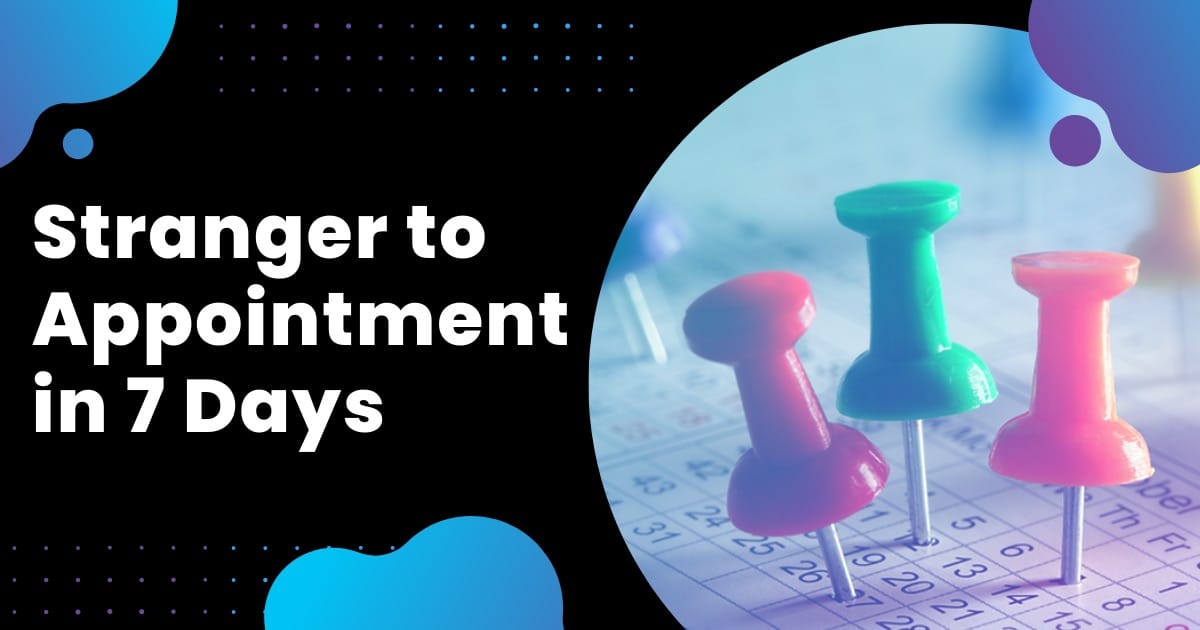The market for any professional service firms and expertise based consultancy businesses is extremely competitive, but with an effective content marketing strategy you can stand out.
Content marketing positions you as an authority and demonstrates niche expertise – but it goes further. It becomes the engine of your marketing, so a content marketing strategy is essential for any professional service…. Great content has the ability to rank in search engines like Google, can fuel your social media marketing activities and email marketing, and can move your ideal clients through the entire customer journey from awareness, to consideration, to purchase, and then to advocacy.
So recognising that many of your potential clients are researching their decision, and will not find about you today and immediately engage you on the spot, a proper content marketing strategy may be responsible for people choosing you over your competitors, and driving an increase in leads and revenue.
Most businesses are aware of the benefits of producing quality content and content marketing in general, in fact studies show that:
- 77% of companies say they have a content marketing strategy. (SEMrush)
- 74% of companies increasing lead quality & quantity from their content, and 75% of companies are increasing content marketing investment (source: curata)
- Inbound marketers are able to double the average site conversion rate (from 6 to 12%), in part due to their content marketing efforts. (HubSpot)
….but so many fall short in being able to execute a content marketing strategy with B2B marketers citing lack of time (69%), producing enough content (55%), and producing the kind of content that engages (47%) as their top three content marketing challenges (source : CMI).
In this guide we will be covering all of the elements you need as a professional service business to stand out in a crowded marketplace.
Table of Contents
- What is content marketing
- Defining your content marketing goals
- Developing buyer personas – who is your ideal client?
- Different content types
- Website content structure
- Long-term planning: the content calendar
- Creating content
- Maximising the value of content
- Repurpose your content to extend its value
- How to use content to close those that are ready, and nurture those that aren’t
- Conclusion: takeaways
An introduction to content marketing
In today’s world we are bombarded with ads all the time, whether they’re useful to us or not. Modern consumers have developed ways to cope with this. An example is banner blindness, where users consciously ignore banner ads on websites.
Content marketing is distinct from advertising. It’s when a company creates content that isn’t directly pitching their products and services. Instead, they provide educational, entertaining or inspiring content to a target audience with no strings attached. It’s all about what your audience actually cares about.
At first glance, this might seem like a waste of money. But surprisingly, content marketing can actually grow your customer base and increase profits. Not just that, it improves brand perception. Content marketing works because when you become an authority on a subject and provide valuable information to people, you earn their loyalty and trust.
Here are some of the main reasons why companies use content marketing:
Getting discovered by new customers
The first place that people go when they have a question is Google. By providing content that Google determines to be valuable, your website will rank high in the search results. This, in turn, will lead to more people finding your business and increased sales. For example, The Adviser Brand created this article to attract service-based business owners that want to learn more about content marketing. And if they happen to need website & marketing services, we’re just a click away.
Engaging their audience & generating recurring revenue
Closing a client is only half the battle. If you want to build a sustainable business, then you have to give them a reason to engage with you on a regular basis. Not to mention, it’s more cost-effective to keep your existing clients happy than it is to go out and find new ones.
Generate a greater ROI on marketing
Traditional marketing channels like billboards, print media and television aren’t as effective anymore. When’s the last time you sat through an entire TV commercial? Not only that, the performance of these marketing channels can’t be accurately tracked. With content marketing, you can draw a direct line between your investment and your ROI. Just don’t expect content marketing to deliver instant results. It’s an investment that will pay dividends down the road.
Content marketing is the foundation of digital marketing because it ties together all the other channels:
- Social media: Content grows your following.
- SEO: Content ranks in search engines and drives people to your website.
- PPC: Content encourages people to click on ads.
- Email: Content builds your email list and keeps engagement up.
Unlike other lead generation strategies, content marketing gives valuable information away to prospects, instead of asking them for something. For B2B marketers, while content marketing can take time to show real results, it’s a strong, long-term approach to improving your brand’s visibility online. It also helps you nurture a stronger relationship with your customers, and has been shown to increase the average lifetime value of a customer.
Defining your content marketing goals
It’s quite possible that the goals of your business may impact the approach you take with your content marketing. A business that is well established and generates its business purely by referral is going to be more focused on developing its brand and keeping existing clients engaged, while a business that is wanting to grow may be more focused on developing content for lead generation and so may be more SEO focused.
It’s easy to say that your content marketing efforts are meant to generate “brand awareness” and just leave it at that. But that’s not specific enough to be relevant to most businesses. Remember, a business has two main objectives:
- Increasing revenue
- Decreasing costs
To make the most of content marketing, you should set goals that are aligned with business objectives. Here’s what performance-driven content marketing goals look like.
Content Marketing for Brand Awareness
The first content marketing goal that marketers tend to think about is brand awareness. Marketers have a plethora of channels to choose from when it comes to brand awareness, most of which are social media. But don’t get too caught up with increasing your follower count. You should be leading users back to your website and encouraging them to sign up for your email list. That’s where the real gold is. Your email list is an asset that you alone control, whereas you’re just borrowing turf on social media.
Business case: Providing so much value that potential customers want to stay in touch with you, gives you the opportunity to sell to them later down the road. Your main success metric here is the number of subscribers in your email list. But aside from that, you can track the number of followers across your social media.
Content Marketing for Lead Generation
While content marketing is geared toward delivering free value, that doesn’t mean it can’t close customers. If a great piece of content convinces a website visitor that you can solve their issue, they will inquire about your services. Case studies and white papers are well suited to this task. But be careful not to confuse leads with subscribers. A subscriber just wants more great content from you, while a lead has expressed interest in buying from you.
Business case: Producing content that ranks high in search engines will generate leads for your business. That’s especially the case if you target transactional keywords. These are keywords that indicate that the searcher is ready to buy (e.g. “marketing agency pricing”). These leads can then be passed off to your sales team for qualifying, nurturing and closing. The two best metrics for this are your website’s conversion rate and sales-qualified leads.
Content Marketing for Sales Enablement
Next to generating leads, content marketing can ease the process of closing customers. When salespeople make claims, they should be able to back them up with proof. Content formats like case studies, testimonials and white papers can do just that.
Business case: It’s tempting to jump right into sales enablement when you’re starting out, but remember what got those leads through the door in the first place: valuable content that isn’t sales-y. Measuring this goal is pretty straightforward. You can simply track it as your sales team’s closing rate and total revenue generated.
Content Marketing for Customer Retention
Content isn’t only useful for converting prospects into customers, but also keeping them happy afterwards. Content formats like FAQs, industry updates and discount offers are just the trick. The key to reducing churn and increasing lifetime client value is staying top of mind and retaining loyalty.
Business case: In the pursuit of increasing their client base, businesses often forget about this one. Just checking in with a previous client after a while can do wonders. Upselling. Secure more revenue. Measure the number of repeat customers and your churn rate.
Who is your ideal client? Developing buyer personas you can market to
When you start making content for your business, it’s easy to fall into the trap of thinking you already know what your customers want. When that’s the case, you create your best guess of what they’re looking for and then wonder why it’s not working. But to make great content you have to know what makes your customers tick.
A buyer persona is a made-up profile of your ideal customer. This is a tool for identifying prospects who are a natural fit for your services. This way, you can tailor your content to their needs and interests at every stage of their buyer’s journey. Moreover, buyer personas also help you weed out unqualified leads.
It’s not uncommon for businesses to have more than one buyer persona, representing different target markets, or up to three roles influencing a buying decision within one organisation. While you can go after a hyper-targeted niche if you want, you can also structure your website and marketing to filter by the market segments you define. But if you’re just getting started, you can avoid overwhelm by developing one persona you will focus on (generally where you see the best potential results), with secondary personas that may not be your initial marketing focus being less fleshed out.
Here’s how to go about making a buyer persona.
Identify your personas
There are two sources that you can base your buyer personas on: market research or talking to prospects/customers. Ideally, you’d start off with the first option, and then make your persona more true to life with the second. If you are well established, it’s very possible your existing client base has a lot of information to be gleaned which will simplify this process.
Question your personas
Once you put together a group of people who resemble your target audience, you can set up surveys and interviews. In these, you can ask them for a combination of:
- Personal details (e.g. their job, company size)
- Interactions with your company/niche (likes, dislikes, how they found you).
Create your persona
Now you have to take everything you discovered during your research and make generalisations about your ideal customer. After identifying the decision maker, the single most important insight is what motivates your persona. What do they want to achieve? What’s stopping them from achieving this? This way, your company can position itself as the solution to their problems.
Name your persona
Companies usually segment their buyer personas by profession (e.g. CEO, marketer, accountant, sales rep). Also, it’s best practice to make persona names an alliteration of their profession and a common first name. For example, Accounting Adam, Marketing Marie, HR Henry.
Content types and formats
There are many types of content, too many to even list. But let’s look at the most effective ones that you can use to engage your personas through different stages of the customer journey.
Articles/Blog Posts
The most widespread and accessible content type is good ‘ole fashioned articles. They don’t take too many resources to create, and they can be optimised for search engines. Articles are a great way for people to land on your website for the first time. If your blog consistently publishes high-quality posts, you can even turn them into repeat visitors.
Here are some common article formats:
- Lists: A numbered list on just about anything. These posts tend to go viral.
- Tutorials: Teaches you how to do anything step-by-step.
- Checklists: A short and sweet list of all the boxes you need to tick to accomplish a task.
- Reviews: Either a review of one product or a comparison between different products.
- Case studies: Covers a problem a business was facing, the solution they came up with, the results they got and how to apply it to other businesses.
Customer Journey Stages: All (esp. Awareness, Interest)
Lead Magnets
Also called Freebies, lead magnets blur the line between different types of content. They can be ebooks, white papers, templates or more. They contain more in-depth and valuable information than articles, which is why they’re given in exchange for the reader’s email address. Lead magnets are often the backbone of many paid traffic campaigns looking to grow their email lists. They are also offered to customers who are close to making a purchasing decision, but need a bit of a nudge.
Customer Journey Stages: Awareness, Consideration
Infographics
How does that cliche go? A picture is worth a thousand words. Infographics let you compress a lot of information into one easy to understand image. They’re often used for summarising statistical data or visualising complex processes. Next to list posts, infographics also tend to get widely shared. This has the added SEO benefit of giving your website more authority through backlinks.
Customer Journey Stages: Everything besides Conversion (Awareness, Interest, Consideration, Retention)
Video
Video has become the most widely consumed medium online. The upside is that they get high levels of engagement, but the downside is that some can take a lot of resources to produce (that being said, regular video content can be easily and affordably produced even with your phone once you have a few things in place). Videos are often used on social media to generate brand awareness, but they can also be used to keep your audience interested with a regular uploading schedule.
Customer Journey Stages: Awareness, Interest
The secret to bringing all of this together is mapping the content requirements to each stage of the customer journey, and then planning the content creation and creating content briefs (outlines) for each piece of content.
Creating an effective website structure for SEO and user experience
To find your services, your ideal customers look for them with Google. Google ranks your website based on how relevant it is to a given search. And the relevancy of your website is largely determined by how much of the content on your site is organised around a specific topic. This is the idea behind content silos: grouping content by topic inside of your website architecture. Here’s what an example of that looks like:
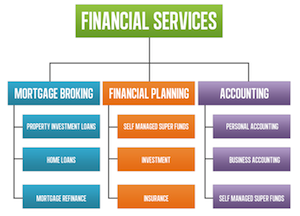
Content silos have two main benefits. They make it easier for:
- Search engines to index and display your web pages in search results
- Visitors to find what they’re looking for on your website.
- And a bonus third, helping you keep your content structured so you can more easily manage the interlinking between pages with relevant content.
There are 3 main steps to adding content silos to your site:
- Finding keywords: These are terms that your audience uses to search for topics in your niche. You can use a tool like Google Keyword Planner or to conduct this research.
- Grouping keywords into silos: Organise your primary keywords into main topics, and with secondary keywords as subtopics.
- Adding content to your silos: Populate your silos with relevant posts on a consistent basis.
You can go deeper into the concept of content silos at the article/free resource level by using topic clusters. This is where you have one long piece of content that gives a comprehensive overview of the topic, often called pillar content, which links to articles that go into more depth on sub topics and those articles also link back to the pillar piece of content.
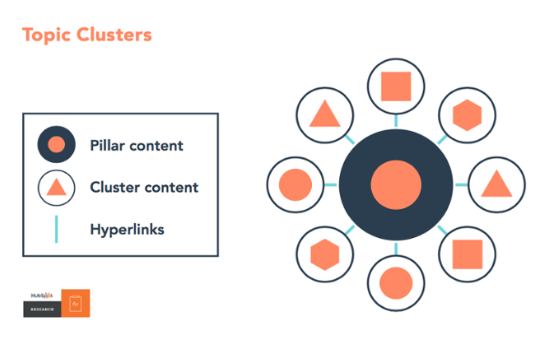 Source: Hubspot
Source: Hubspot
Using website silos and topic clusters are extremely powerful in boosting your SEO.
Long-term content planning and your content calendar
When you commit to creating content on a regular basis, you need a content calendar to plan it all out. A content calendar shows you everything you’re planning to publish on any given week, month or year. The big picture view also allows you to see the key dates and events you should plan your content around.
Having a content plan in place is what makes the production process easier and ensures you maintain consistency. Mapping out your content and deadlines means you will never sit down with a blank document in front of you wondering what to write, and every piece of content fits into an overall strategy that can bear fruit well into the future.
Creating content
There are 3 ways to go about creating content:
- In-source it from colleagues
- Create it yourself
- Outsource content creation
In-sourcing content from colleagues
Some companies want to experience the benefits of content marketing, but don’t have the resources to hire full-time content creators. That’s where in-sourcing comes in. In-sourcing is relying on employees or colleagues, who are not technically content creators, to create content for a company blog or social media.
Due to this becoming an extra workload, it may require some convincing. But who better to produce content for customers, than the people who are directly dealing with them every day?
Here are 4 things you can do to get your colleagues on board:
- Encourage them to contribute by explaining how valuable their insights are.
- Give them clear guidelines and topics that play to their strengths, so they know exactly what is expected of them and can do a good job at it.
- Promote your colleagues’ contributions to make the whole process more rewarding.
- Give them the option of having someone that can polish up their content if they are not confident.
Creating content yourself
The key to creating content consistently is having a well-defined process. Here’s what that looks like.
Ideation
They say ideas are a dime a dozen, but sometimes coming up with ideas is the hardest part. It doesn’t have to be though, since everything around us can serve as inspiration for ideas. Here are a few tried and true methods to get your creative juices flowing:
- Keyword research: Find search volume and difficulty of the words and phrases that your customers are searching for.
- Customer feedback: Search forums and social media for the topics your customers are talking about.
- Take suggestions: Take advantage of all your colleagues’ customer interactions to ask them for content suggestions.
- Competitor analysis: Spy on your competitors by looking at what they’re posting, where they’re posting it. Take what is useful to your business and discard the rest.
Planning
Now that you have a strong idea, there are two considerations when choosing what content type it should be:
- What’s the best format for this idea? This could be as an article, infographic, video or something else.
- What is everybody else doing? An effective way to differentiate yourself is to create content in a format that is under utilised. E.g. if everyone else is covering this topic with articles, maybe you should make a video.
A few other things to keep in mind when planning your content:
- How many pieces of content is required to cover this topic?
- Which buyer persona is this content for?
- Where does this content fit into the buyer’s journey?
- What resources do I need to make this a reality?
Creation
This part doesn’t need much explaining. Just stick to the plan and write, design, film or do whatever it is you do.
Outsourcing content creation
Maybe your in-house team is already swamped with projects, or you just don’t have the resources to hire full-time content creators. No problem. There are two ways to approach this. You can spend a lot of time and energy looking for a writer who ticks all the right boxes:
- Has experience in your niche.
- Writes great content without grammatical errors.
- Has the monthly availability for your projects.
- Is able to help you craft a strategy for your content marketing.
- Delivers the work on time.
- Will revise the content until you are satisfied.
- Is affordable.
Now that is a tall order. Looking for a writer who fits all those criteria is like looking for a needle in a haystack. Alternatively, you can outsource your content creation needs to an agency who specialises in service-based businesses. But if you choose to go with the first option anyway, here’s what that would involve.
Requirements
These are a few questions you should have answers to before you reach out to contractors:
- What kind of content do they need to create?
- Is this a one-time thing or a long-term opportunity?
- How much work should they expect from you?
- What style guidelines do they need to meet?
- How will they be compensated? Per-project or by the hour?
Finding Talent
Now that you know exactly what you need, you can find qualified professionals in the following ways:
- Recommendations: Ask your network if they know any good content creators.
- Job boards: Post to job boards like ProBlogger and Upwork.
- Content marketing agency: Best if you want everything from strategy to content briefs to content production and promotion.
- Publications: Identify posts that you like and reach out to the credited author directly.
Vetting Talent
To avoid a lot of wasted time, you should ruthlessly vet everyone you’re considering with these questions:
- How do they work? Do you just give them a topic, or do they require a content brief?
- Do they have relevant experience in your niche?
- How much availability do they have for your workload?
- What rates do they charge? Are you able to afford that?
You can apply this vetting process to make a shortlist of the most qualified talent.
Finally, you can give them a test to prove their skills to you (expect to pay as only the least experienced will be desperate enough to do something for nothing).
Equipping Talent
Once you’ve chosen your candidate, you should equip them with the resources they need to do a good job. Those key resources should include:
- Content strategy/Calendar: Just about everything we covered in this post, from your target audience to your preferred content formats and planned posts.
- Educational material/Style guide: These could be courses that get them up to speed on the best practices in your niche, or style guides that they have to comply with to uphold content quality standards.
- Tools: Whatever hardware or software this may be, from keyword research tools to grammar checkers.
Content Briefs
This is really part of “equipping talent”, but is so important that it requires it’s own section. 9 times out of 10, without a strong content brief you’re not going to be happy with the results, it probably won’t effectively address all of the important points, and it will not be of sufficient merit to have a chance of ranking in Google.
An effective content brief will:
- Give the writer context – who you are, who you are targeting and the solutions you provide.
- Important points to address and where to link to for further information on your website.
- Links to content where the topic(s) has been covered well.
- Give an indication of required length of the article. A good guide is to look at the length of content for the results coming up in Google for the search term you are targeting. There is no arbitrary figure – we have an article that is only 400 words that was written in 2010 and is getting 1500 visits per month still…but this is definitely not the case for all articles.
- List primary and secondary keywords you are wanting to target.
- Wireframe the whole article with headings and subheadings, with consideration to your keywords.
Although above we have targeted article writing, a content brief is just as important when doing other content formats like infographics and video.
If SEO (search engine optimisation) and organic traffic is important to you, a content brief is a result of an analysis of the top 10-20 results for a search term. The goal of any piece of content is that it addresses all of the points addressed by your competition, and is at least as good as the content that is already ranking…if you’re content is not as good, or better, why should Google rank it over your competitors?
As you can see, this is a very time-consuming process. But you can save yourself the hassle of finding, vetting and equipping creators who can get the job done on time and within budget. Simply outsource your content creation to a trusted agency like The Adviser Brand. Take a look at our simple and transparent pricing for all of your content needs.
Maximising the value of your content
If a tree falls in the forest, and no one’s around to hear it, does it make a sound? You’ve put all this hard work into thinking up ideas, planning your content and even making (or outsourcing) it. The final step in content marketing is to promote it. Otherwise, how does this generate an ROI?
Content promotion is the way you distribute your content through the marketing channels available to you. These include your blog, email list, and social media and search engines. The way you promote your content will determine whether potential customers will find you, your existing audience continues to engage with you, and previous customers continue to buy from you. So there’s a lot riding on this.
There are two overarching ways to promote: organic promotion, and paid promotion. Organic promotion is when you drive traffic to your content without the use of ads. The obvious benefit here is that your efforts aren’t limited by a budget. But the downside is that these channels can take longer to start producing results. Some organic promotion channels are:
- SEO
- Social media
- Word of mouth
Paid content promotion is when you drive traffic to your content using ads. The benefit of paid advertising platforms is that they provide advertisers with a comprehensive list of targeting options. Fine-tuning your targeting can ensure that your content reaches your ideal customers. The downside of paid content promotion is that it might require a high budget to generate a significant amount of customers. Ideally, what you make off your customers should cover the cost to acquire them with paid traffic. Ads require a lot of testing, from the creative to the targeting, to develop such cost-effective campaigns. Some paid promotion channels are:
- Google Ads
- Bing Ads
- Facebook Ads
- LinkedIn Ads
- Twitter Ads
But one thing that both promotional methods require above all else is great content. If your content doesn’t provide value to your audience, they won’t engage no matter how many dollars you throw at it. This, of course, reinforces the value of understanding who you’re marketing to and what they are looking for.T
Repurposing your content to extend its value
Pulling all of the ideas together to create a piece of content is a significant investment of time, but once it’s out there, why stop there. People consume content in all different formats, and there are different platforms for different content formats.
An article could be:
- A script for producing a video and/or podcast
- Summarised and turned into an infographic
- Broken up into micro-content for social media
A video could be:
- Transcribed and added after the video in your website blog to allow people to read your content and make the blog post more search engine friendly.
- Split into an audio clip for a podcast
If you want to be an absolute content machine check out this content repurposing stratgey to share 64 pieces of content in a day!
How to use content to close those that are ready, and nurture those that aren’t
There is nothing wrong with running promotions to attract new leads, but outside specific searches in Google, a lot of people are not in the looking zone right now – either because they don’t know there is a solution to a problem they are experiencing, or they are not aware that the current solution they are using is not the best.
Here’s a real model that is used by many running paid traffic campaigns, using content to filter and qualify the target audience, i.e. if people do not engage they do not see the next part of the funnel. This is an effective way to control wasted ad spend.
This is a content driven funnel that raises awareness, drives people to a value-driven opt-in and then educates to set up a qualified appointment…and up until the actual appointment this can all be automated!
Here’s how that looks:
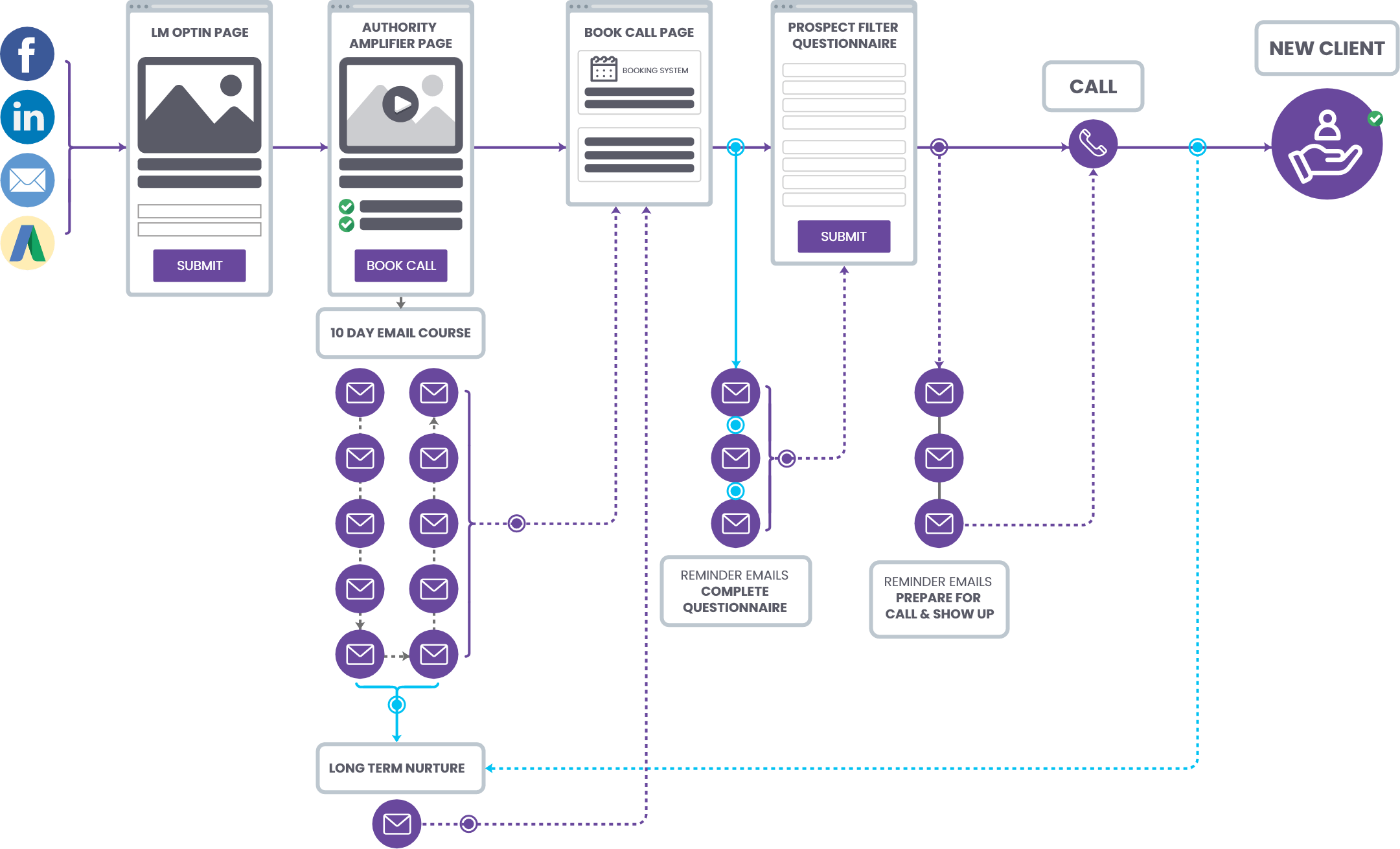
And to drive people into that funnel we use content. That content can be blog articles that people read on your site after finding it in Google or seeing it shared in social media, videos they find on Youtube or LinkedIn, or even an email shared to your existing database. Content is what we use to filter the target audience – if someone watches >50% of one of your videos on Facebook then they qualify to the next step, e.g. a promotion of a template or some other resource that someone may opt in to.
The question you might ask is, “Why not just send them to the promo straight away?”
If you were selling a low deposit first home buyer opportunity and running a Facebook Ads campaign you could:
- Create a target audience made up of people aged between 20 and 35, in location X
- Promote an article “How first home buyers are getting into the market in location X”
- If people click to read they remain targeted in the campaign
- People that don’t click see other “click-bait” content to encourage engagement, or removed from targeting.
- Article has a link to an option to see if they qualify for the “low deposit first home buyer opportunity”
- The complete questionnaire and are removed from targeting of campaign
- They do not complete questionnaire and are tagged to go deeper into the campaign funnel
- Individuals that have read that article see promotion of “low deposit first home buyer opportunity”, or other young people testimonial-style posts, encouraging them to see if they qualify by completing the questionnaire.
This is an approach that actually delivers sales qualified leads, i.e. they have been pre-qualified by the funnel as ready to take action, and those that don’t qualify yet have been excluded from your targeting, or become part of your long term nurture campaign. At the same time we are refining our marketing audiences, and only delivering to the broader, untargeted audiences content that is more likely to get engagement with lower ad costs, while the promotions that may have higher delivery costs are only targeted to those that are most likely to convert.
In practice this looks something like the following diagram, and you can see up until the point of the appointment it’s the automated distribution of content, and for those that become part of the long term nurture program they will be receiving your content until they either unsubscribe, or they are ready to take action.
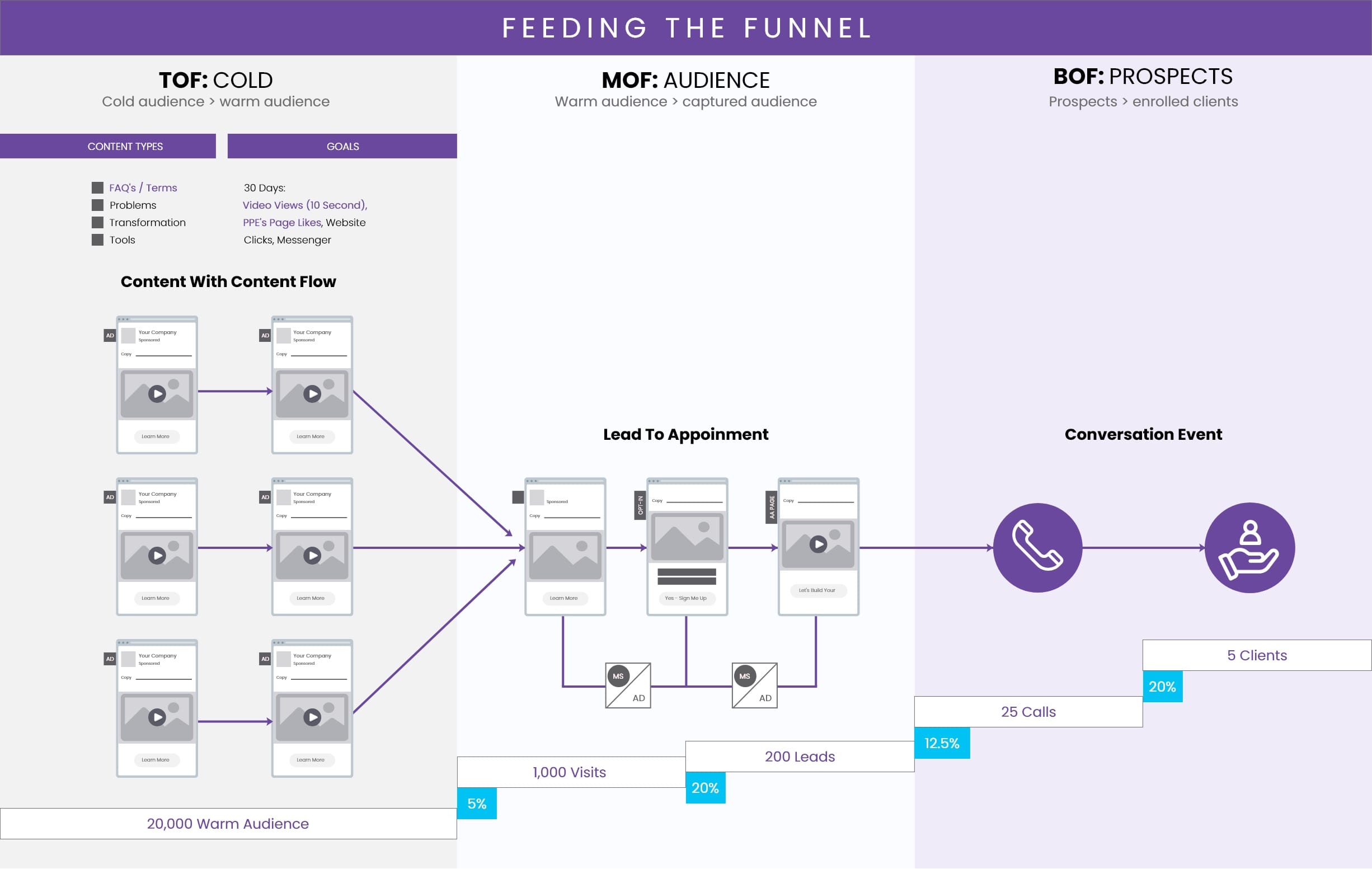
Conclusion: Next Steps
Let’s recap everything we learned in this guide for creating a content marketing strategy for professional services, shall we?
Content Marketing is an effective way to reach your target audience and increase your revenue. Different goals can be pursued in line with this to meet business objectives. Before any content is made, however, you should get a clear idea of who your ideal client is. Next to that, you should set your website up so that it’s easy to find by search engines and provides a great user experience for your ideal client.
With the marketing basics in place it’s time to dive into your content marketing strategy and start producing content regularly. By understanding your ideal client, the questions they have and what will guide them through the marketing journey it becomes easy to pull together a production schedule and content calendar for promoting your content, and milk every piece of content to drive traffic, engagement and conversions.
If you do content marketing right, content you produce today could deliver results for years to come!
If you want to shortcut the process, talk to us about putting in place your content marketing strategy, producing your content briefs and creating your content.





